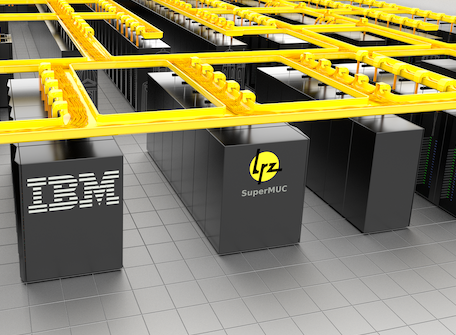German researchers are helping to push back the goalposts on large-scale simulation. Using the the IBM “SuperMUC” high performance computer at the Leibniz Supercomputing Center (LRZ), a cross-disciplinary team of computer scientists, mathematicians and geophysicists successfully scaled an earthquake simulation to more than one petaflop/s, i.e., one quadrillion floating point operations per second.
The collaboration included participants from Technische Universitaet Muenchen (TUM) and Ludwig-Maximillians Universitaet Muenchen (LMU) working in partnership with the Leibniz Supercomputing Center of the Bavarian Academy of Sciences and Humanities.
The effort hinged on retooling the SeisSol earthquake simulation code to harness more than one hundred thousand cores and over one petaflops of computing power. The popular simulation software is used in the study of rupture processes and seismic waves beneath the Earth’s surface. The goal of this geophysics project was to simulate earthquakes as accurately as possible, paving the way for improved predictive efforts. The project faced a limiting factor, however, in that the computational element was challenging even for a leadership-class system like the 3-petaflops SuperMUC, one of the world’s fastest.
To push beyond this barrier, Dr. Christian Pelties at the Department of Geo and Environmental Sciences at LMU teamed up with Professor Michael Bader at the Department of Informatics at TUM. The duo formed workgroups focused on optimizing the SeisSol program, tuning it for the parallel architecture of “SuperMUC.” The result was an impressive five-fold speedup and a new record on the SuperMUC.

In a virtual experiment, the team simulated the vibrations inside the geometrically complex Merapi volcano, located on the island of Java. The supercomputer chewed through the problem at 1.09 quadrillion floating point operations per second. And this wasn’t just a momentary peak, SeisSol maintained this high performance level during the entire three hour simulation run, incorporating all of SuperMUC’s 147,456 “Sandy Bridge” processor cores.
The official news release from LRZ asserts that this was only possible due to the extensive optimization and the complete parallelization of the 70,000 lines of SeisSol code, enabling peak performance of up to 1.42 petaflops. This corresponds to 44.5 percent of Super MUC’s theoretically available capacity (3.185 petaflops), making “SeisSol one of the most efficient simulation programs of its kind worldwide,” according to the institution.
“Thanks to the extreme performance now achievable, we can run five times as many models or models that are five times as large to achieve significantly more accurate results. Our simulations are thus inching ever closer to reality,” observes project lead Dr. Christian Pelties. “This will allow us to better understand many fundamental mechanisms of earthquakes and hopefully be better prepared for future events.”
“Speeding up the simulation software by a factor of five is not only an important step for geophysical research,” notes co-lead Professor Michael Bader of the Department of Informatics at TUM. “We are, at the same time, preparing the applied methodologies and software packages for the next generation of supercomputers that will routinely host the respective simulations for diverse geoscience applications.”
The researchers are planning to extend the project to simulate rupture processes at the meter scale as well as the seismic waves that propagate for hundreds of kilometers. The work has the potential to help humanity better prepare for these often damaging, and even deadly, natural forces.
SuperMUC, which was the world’s fourth fastest when it debuted in 2012, employs Intel Xeon processors running in IBM System x iDataPlex servers and has a LINPACK performance of 2.897 petaflops. It touts an innovative warm-water cooling system developed by IBM called Aquasar. The system currently holds the tenth spot on the TOP500 list and LRZ expects to double its performance in 2015.
The US Sequoia supercomputer (with 20 petaflops peak capability) may have trail-blazed the sustained petascale application front, but this level of scale is essential if exascale timelines are to be met. The earthquake simulation project will be highlighted at the International Supercomputing Conference in Leipzig, Germany this June with the session title: “Sustained Petascale Performance of Seismic Simulation with SeisSol on SuperMUC.”




























































